Chapter 4 目标规划
- 格式:ppt
- 大小:1.14 MB
- 文档页数:62
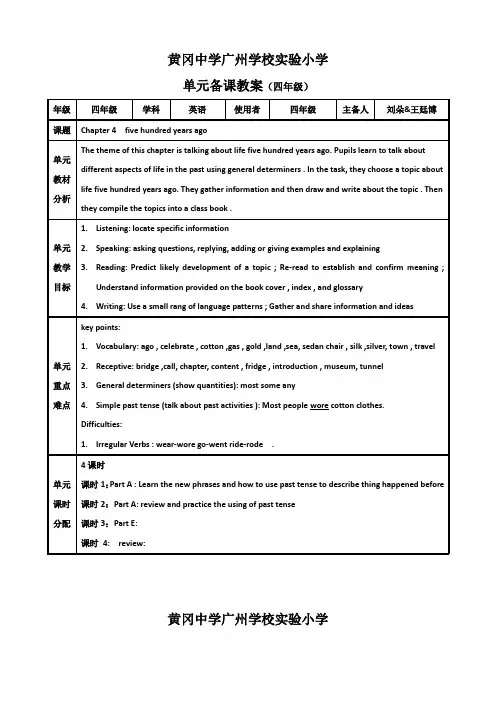
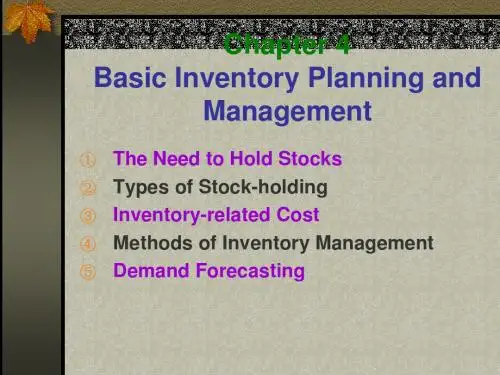
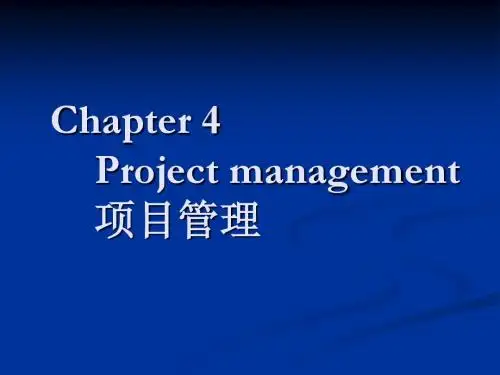
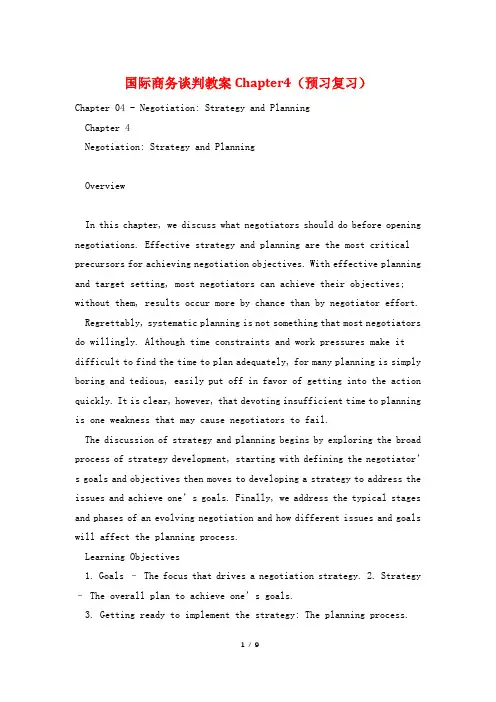
国际商务谈判教案Chapter4(预习复习)Chapter 04 - Negotiation: Strategy and PlanningChapter 4Negotiation: Strategy and PlanningOverviewIn this chapter, we discuss what negotiators should do before opening negotiations. Effective strategy and planning are the most critical precursors for achieving negotiation objectives. With effective planning and target setting, most negotiators can achieve their objectives; without them, results occur more by chance than by negotiator effort. Regrettably, systematic planning is not something that most negotiatorsdo willingly. Although time constraints and work pressures make it difficult to find the time to plan adequately, for many planning is simply boring and tedious, easily put off in favor of getting into the action quickly. It is clear, however, that devoting insufficient time to planningis one weakness that may cause negotiators to fail.The discussion of strategy and planning begins by exploring the broad process of strategy development, starting with defining the negotiator’s goals and objectives then moves to developing a strategy to address the issues and achieve one’s goals. Finally, we address the typical stages and phases of an evolving negotiation and how different issues and goals will affect the planning process.Learning Objectives1. Goals – The focus that drives a negotiation strategy.2. Strategy– The overall plan to achieve one’s goals.3. Getting ready to implement the strategy: The planning process.I. Goals – The Focus That Drives a Negotiation StrategyA. Direct effects of goals on choice of strategy1. There are four important aspects to understand about how goals affect negotiations: a. Wishes are not goals, especially in negotiation. b. Goals are often linked to the other party’s goals. c. There are boundaries or limits to what goals can be.d. Effective goals must be concrete, specific and measurable. If they are not, then itwill be hard to:(1) Communicate to the other party what we want (2) Understand what the other party wants(3) Determine whether an offer on the table satisfies our goals.2. Goals can be tangible or procedural.4-1Chapter 04 - Negotiation: Strategy and Planning3. The criteria used to determine goals depend on your specific objectives and your priorities among multiple objectives.B. Indirect effects of goals on choice of strategy1. Short-term thinking affects our choice of strategy; in developing and framing our goals, we may ignore the present or future relationship with the other party in a concern for achieving a substantive outcome only.2. Negotiation goals that are complex or difficult to define may requirea substantial change in the other party’s attitude. In most cases, progress will be madeincrementally, and may depend on establishing a relationship with the other party.II. Strategy – The Overall Plan to Achieve One’s GoalsA. Strategy versus Tactics1. A major difference between strategy and tactics is that of scale, perspective or immediacy.2. Tactics are short-term, adaptive moves designed to enact or pursue broad strategies, which in turn provide stability, continuity, and direction for tactical behaviors.3. Tactics are subordinate to strategy: they are structured, directed, and driven by strategic considerations.B. Unilateral versus bilateral approaches to strategy1. A unilateral choice is made without the active involvement of the other party.2. Unilaterally pursued strategies can be wholly one-sided and intentionally ignorant of any information about the other negotiator.3. Unilateral strategies should evolve into ones that fully consider the impact of the other’s strategy on one’s own.C. The dual concerns model as a vehicle for describing negotiation strategies. This model proposes that individuals have two levels of related concerns: a concern for their own outcomes, and a level of concern for the other’s outcomes.1. Alternative situational strategiesa. There are at least four different types of strategies when assessing the relativeimportance and priority of the negotiator’s substantive outcome versus the relational outcome: competitive, collaboration, accommodation, and avoidance2. The nonengagement strategy: Avoidancea. There are many reasons why negotiators may choose not to negotiate:(1) If one is able to meet one’s needs without negotiating at all, it may make sense to use an avoidance strategy(2) It simply may not be worth the time and effort to negotiate (although there are sometimes reasons to negotiate in such situations4-2Chapter 04 - Negotiation: Strategy and Planning(3) The decision to negotiate is closely related to the desirability of availablealternatives – the outcomes that can be achieved if negotiations don’t work out3. Active-engagement strategies: Competition, collaboration, and accommodation a. Competition is distributive win-lose bargaining. b. Collaboration is integrative or win-win negotiation.c. Accommodation is as much a win-lose strategy as competition, although it has adecidedly different image it involves an imbalance of outcomes, but in the opposite direction. (“I lose, you win” as opposed to “I win, you lose.”) d. There are drawbacks to these strategies if applied blindly, thoughtlessly orinflexibly:(1) Distributive strategies tend to create “we-they” or “superiority-inferiority” patterns, which may result in a distortion of the other side’s contributions, as well as their values, needs and positions.(2) If a negotiator pursues an integrative strategy without regard to the other’s strategy, then the other may manipulate and exploit the collaborator and take advantage of the good faith and goodwill being demonstrated.(3) Accommodative strategies may generate a pattern of constantly giving in to keep the other happy or to avoid a fight.III. Understanding the Flow of Negotiations: Stages and PhasesA. Phase models of negotiation:1. Initiation2. Problem solving3. ResolutionB. Greenhalgh (2001) suggests that there are seven key steps to an ideal negotiation process:1. Preparation: deciding what is important, defining goals, thinking ahead how to work together with the other party.2. Relationship building: getting to know the other party, understanding how you and the other are similar and different, and building commitment toward achieving a mutually beneficial set of outcomes.3. Information gathering: learning what you need to know about the issues, about the other party and their needs, about the feasibility of possible settlements, and about what might happen if you fail to reach agreement with the other side.4. Information using: at this stage, negotiators assemble the case they want to make for their preferred outcomes and settlement, one that will maximize the negotiator’s own needs.5. Bidding: the process of making moves from one’s initial, ideal position to the actual outcome.6. Closing the deal: the objective here is to build commitment to the agreement achieved in the previous phase.7. Implementing the agreement: determining who needs to do what once hands are shaken and the documents signed.4-3Chapter 04 - Negotiation: Strategy and PlanningIV. Getting Ready to Implement the Strategy: The Planning Process A. Defining the issues1. Usually begins with an analysis of what is to be discussed in the negotiation.2. The number of issues in a negotiation, along with the relationship between thenegotiator and the other party, are often the primary determinant of whether one uses a distributive or integrative strategy.3. In any negotiation, a complete list of the issues at stake is best derived from the following sources:a. An analysis of all the possible issues that need to be decided.b. Previous experience in similar negotiations.c. Research conducted to gather information.d. Consultation with experts in that industry.B. Assembling the issues and defining the bargaining mix1. The combination of lists from each side in a negotiation determines the bargaining mix.2. There are two steps a negotiator can use to prioritize the issues on an agenda: a. Determine which issues are most important and which are less important. b. Determine whether the issues are linked together or are separate.C. Defining Interests1. Interests may be:a. Substantive, that is, directly related to the focal issues under negotiation.b. Process-based, that is, related to how the negotiators behave as they negotiate.c. Relationship-based, that is, tied to the current or desired future relationshipbetween the parties.2. Interests may also be based on intangibles of negotiation.D. Knowing limits and alternatives1. Good preparation requires that you establish two clear points:a. Resistance point – the place where you decide that you should absolutely stop thenegotiation rather than continue.b. Alternatives – other agreements negotiators could achieve and still meet theirneeds. Alternatives define whether the current outcome is better than another possibility.E. Setting targets and openings1. Two key points should be defined in this step:a. The specific target point where one realistically expects to achieve a settlement4-4Chapter 04 - Negotiation: Strategy and Planningb. The asking price, representing the best deal one can hope to achieve.2. Target setting requires positive thinking about one’s own objectives.3. Target setting often requires considering how to package several issues and objectives.4. Target setting requires an understanding of trade-offs and throwaways.F. Assessing constituents and the social context of a negotiation1. When people negotiate in a professional context, there may be more than two parties. a. There may be more than two negotiators at the table. Multiple parties often leadto the formation of coalitions.b. Negotiators also have constituents who will evaluate and critique them.c. Negotiation occurs in a context of rules – a social system of laws, customs,common business practices, cultural norms, and politicalcross-pressures.2. “Field analysis” can be used to assess all the key parties in a negotiation. a. Who is, or should be, on the team on my side of the field?b. Who is on the other side of the field?c. Who is on the sidelines and can affect the play of the game? Who are thenegotiation equivalents of owners, managers and strategists?d. Who is in the stands? Who is watching the game, is interested in it, but can onlyindirectly affect what happens?e. What is going on in the broader environment in which the negotiation takesplace?f. What is common and acceptable practice in the ethical system in which the deal isbeing done?g. What is common and acceptable practice given the culture in which thenegotiation is conducted?G. Analyzing the other party1. Learning the other’s issues, preferences, priorities, interests, alternatives and constraints is almost as important as determining one’s own.2. Several key pieces of background information will be of great importance, including: a. The other party’s resources, issues, and bargaining mix – investigate:(1) Other party’s business history or previous negotiations. (2) Financial data. (3) Inventories.(4) Visit or speak with the other party’s friends and peers. (5) Question past business partners. b. The other party’s interests and needs.(1) Conduct a preliminary interview including a broad discussion of what the other party would like to achieve in the upcoming negotiations. (2) Anticipating the other party’s interests.(3) Asking others who know or have negotiated with the other party. (4) Reading how the other party portrays him/herself in the media.4-5。
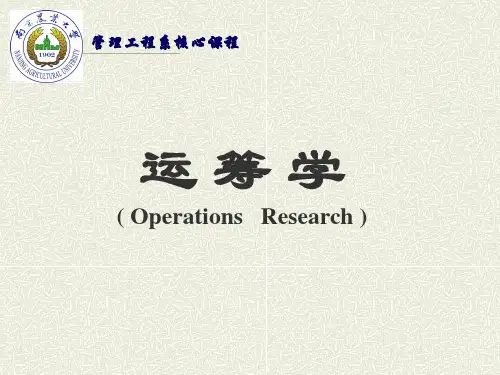
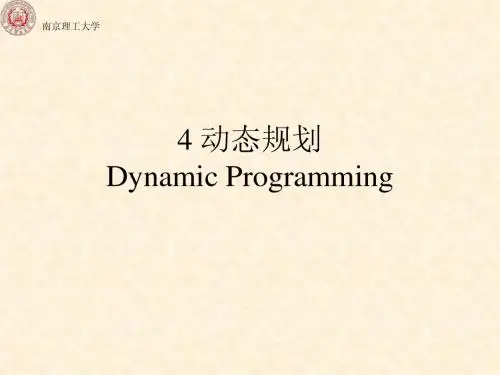


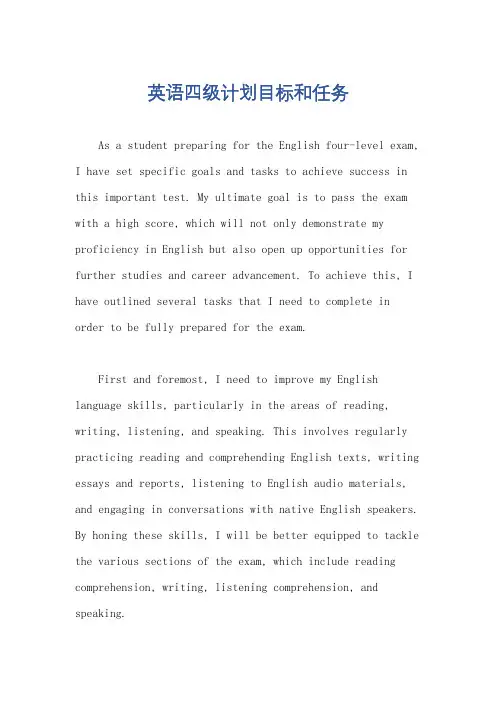
英语四级计划目标和任务As a student preparing for the English four-level exam, I have set specific goals and tasks to achieve success in this important test. My ultimate goal is to pass the exam with a high score, which will not only demonstrate my proficiency in English but also open up opportunities for further studies and career advancement. To achieve this, I have outlined several tasks that I need to complete in order to be fully prepared for the exam.First and foremost, I need to improve my English language skills, particularly in the areas of reading, writing, listening, and speaking. This involves regularly practicing reading and comprehending English texts, writing essays and reports, listening to English audio materials, and engaging in conversations with native English speakers. By honing these skills, I will be better equipped to tackle the various sections of the exam, which include reading comprehension, writing, listening comprehension, and speaking.In addition to improving my language skills, I also need to familiarize myself with the format and structure of the English four-level exam. This means studying past exam papers, understanding the types of questions that are typically asked, and practicing under timed conditions to simulate the actual exam experience. By doing so, I will be able to develop effective test-taking strategies and become more comfortable with the exam format, which willultimately improve my performance on the day of the test.Another important task is to expand my vocabulary and improve my grammar. This involves regularly learning new words, phrases, and idioms, as well as practicing grammar exercises to reinforce my understanding of English grammar rules. A strong vocabulary and solid grasp of grammar are essential for achieving a high score on the exam, as they are fundamental to effectively communicating in English and understanding written and spoken English.Furthermore, I need to stay updated on current affairs and general knowledge, as these are often topics that aretested in the English four-level exam. This involves reading newspapers, magazines, and online articles, as well as watching news programs and documentaries in English. By staying informed about a wide range of topics, I will be better prepared to answer questions related to current events, social issues, and general knowledge, which are often included in the exam.Moreover, I need to practice time management and develop a study schedule that allows me to allocate sufficient time to each aspect of exam preparation. This involves setting aside dedicated time for reading, writing, listening, speaking, vocabulary building, grammar practice, and mock exams. By effectively managing my time and adhering to a structured study plan, I will be able to cover all the necessary material and skills required for the exam, without feeling overwhelmed or rushed.Finally, I need to stay motivated and maintain a positive mindset throughout my exam preparation. This involves setting realistic expectations, celebrating small victories, seeking support from peers and mentors, andstaying focused on my long-term goals. By staying motivated and optimistic, I will be able to overcome any challengesor setbacks that I may encounter during my exam preparation, and ultimately achieve success in the English four-level exam.。
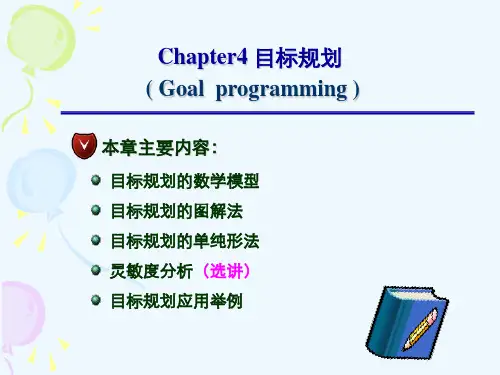

第三次作业宋子瑶经济1503 415076632.Describe in detail the six-step strategic management process.The strategy management process is a six-step process that encompasses strategy planning, implementation and evaluation.The first step is identifying the organization’ s current mission, goals and strategies. Every organization needs a mission-a statement of its purpose. Defining the mission forces managers to identify what it’ s in business to do. It’s also important for managers to identify the current goals and strategies for managers have a basis for assessing whether they need to be changed.The second step is doing an external analysis. Analyzing that environment is a critical step in the strategic management process. Once the managers’ve analyzed the environment, managers need to pinpoint opportunities that the organization can exploit and threats that it must counteract or buffer against. And opportunities are positive trends in the external environment and threats are negative trends.The third step is doing an internal analysis. The internal analysis provides important information about an organization’s specific resources and capabilities. After completing an internal analysis, managers should be able to identify organizational strengths and weakness. The combined external and internal analyses are called the SWOT analysis, which is an analysis of the organization’s strengths, weakness, opportunities, andthreats.The forth step is formulating strategies. As managers formulate strategies, they develop and evaluate strategic alternatives, select appropriate strategies for all levels in the organization that provide relative advantages over competitors, match organizational strengths to environmental opportunities, and correct weaknesses and guard against threat.The fifth step is implementing strategies. Once strategies are formulated, they must be implemented. No matter how effectively an organization has planned its strategies, performance will suffer if the strategies aren’t implemented properly.The sixth step is evaluating results. There are many problems managers can meet with, such as how effective the manager have been at helping the organization reach its goal, what adjustments are necessary and so on.5.Under what circumstances do you believe MBO would be most useful? Discuss.From my point, MBO would be most useful under the circumstances where departmental, team and individual goals are vital to planing and directing. What’s more, MBO would be also most useful under the circumstances where communication and efficiency are necessary. Management by objectives (MBO) is a process of setting mutually agreed-upon goals and using those goals to evaluate employeeperformance. MBO programs have four elements: goals specificity, participative decision making, an explicit time period, and performance feedback.If a manager were to use this approach, he or she should sit down with each member of the team and set goals and periodically review whether progress was being made toward achieving those goals. That is exactly the biggest difference from traditional goal setting. This way lays emphasis on specific goals. What’ more, instead of using goals to make sure employees are doing what they’re supposed to be doing, MBO uses goals to motivate them as well. Studies also have shown that it can increase employee performance and organizational productivity. We can see that when communication and efficiency are necessary, MBO plays an important role.6.Find examples in current business periodicals of each of Porter’ s genetic strategies. Name the company, describe the strategy being used, and explain why it’ s an example of that strategy. Be sure to cite your sources.As for the cost leadership strategy, I choose XiaoMi Tech from the periodical Wired. W hen an organization competes on the basis of having the lowest costs in its industry, it is following a cost leadership strategy. As we all know, XiaoMi is famous for its reasonable and acceptable prices for mobile phones with the same configuration. The firm doeseverything it can to cut costs. For example, its unique phone system called MIUI, is an innovation as well as an important factor related with the price of single phone. What’ more, the use of hunger marketing is the outcome of low costs.As for the differentiation strategy, I choose Haier from the periodical Fortune Magazine. Haier competes by offering unique products that are widely valued by customers. Once Haier produced a kind of the washing machine specially designed for rural areas and mountain areas. This kind of machine not only has the function of twin-tube washing machine, but also meet the need of people in mountain areas that is cleaning vegetables and fruits with sand. This is a typical example of innovation and differentiation.As for the focus strategy, I choose Coco Cola from the periodical Fortune Magazine.The two strategies above are aimed at the broad market, the focus strategy involves a cost advantage or a differentiation advantage in a narrow segment or niche. When it comes to soft drinks, Coca Cola is the biggest selling brand name in Britain. In the narrow market of cola, after several strategic changes, Coco Cola finally holds on to it initial formula with the unique taste, exactly for which there are so many regular customers as well as new customers and for which Coco Cola can maintain its market share.。
英语四级目标管理方案English Level 4 Target Management Plan.Introduction.To achieve success in English language learning, it is crucial to have a well-defined target management plan. This plan should outline specific goals, strategies, and timelines for achieving the desired level of proficiency, which in this case, is English Level 4. This plan will serve as a roadmap, guiding the learner through the journey of language acquisition and helping them stay on track towards their ultimate goal.Goal Setting.The first step in developing a target management planis to establish clear and measurable goals. For English Level 4, the specific goals may include:Achieving a score of at least 80% on the English Level 4 assessment.Developing fluency in spoken and written English.Expanding vocabulary to include at least 5,000 words.Mastering advanced grammar concepts and structures.Strategies.Once the goals have been established, it is time to identify effective strategies for achieving them. These strategies may include:Regular and consistent study: Dedicate specific time slots each day or week to English learning.Immersion: Surround yourself with English by watching movies, listening to music, reading books, and engaging in conversations with native speakers.Active practice: Engage in speaking, writing, listening, and reading activities to develop all language skills.Structured learning: Utilize textbooks, online courses, or language classes to provide a structured approach to language acquisition.Feedback and assessment: Seek feedback from teachers, peers, or native speakers to identify areas for improvement and track progress.Timeline.To ensure that the goals are achieved in a timely manner, it is important to set realistic timelines. The timeline should take into account the learner's currentlevel of proficiency, the amount of time available for study, and the complexity of the goals. For example, a learner with no prior knowledge of English may require a longer timeline than someone who has already reachedEnglish Level 3.Evaluation and Adjustment.Regular evaluation is essential to monitor progress and make adjustments to the plan as needed. This may involve assessing vocabulary growth, grammar comprehension,speaking and writing skills, and overall fluency. Based on the evaluation results, the strategies or timeline may be adjusted to optimize the learning process.Resources.To support the target management plan, it is importantto have access to a variety of resources. These may include:Textbooks and workbooks.Online courses and language learning apps.Dictionaries and grammar books.Native speaker conversation partners.English language clubs and workshops.Motivation.Staying motivated throughout the journey is crucial for success. Intrinsic motivation, such as the desire to improve communication skills or advance career opportunities, can be a powerful driving force. Additionally, setting short-term goals and rewarding oneself for milestones achieved can help maintain enthusiasm.Conclusion.By following a well-structured target management plan, learners can effectively achieve English Level 4 proficiency. This plan provides a blueprint for setting goals, implementing strategies, managing timelines, evaluating progress, and leveraging resources. With consistent effort, dedication, and a positive mindset, learners can unlock the doors to improved English languageskills and expand their opportunities for communication, work, and personal growth.。